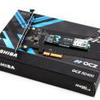Specifications & Features
What's Toshiba OCZ RD400 PCIe NVME SSD About?
So the idea and principles behind the product remain simple, NAND storage like SSDs use placed onto a PCB delivering all the goodness over the PCIe bus, that is the basic essence of what we are talking about. The NAND flash type used has been changed to the newer and all too familiar 15nm series and last but not least, you'll spot a proprietary Toshiba controller being used.
The new RD400 (the artist formerly known as RevoDrive) is a bit unlike what you are used to as in the past we had a PCB with controllers and SSD NAND units. This round it simply is an M.2. PCIe 3.0 (x4) SSD with (for this SKU) add-in card. That also means you can simply drop this unit into your m.2. slot as long as it has PCIe 3.0 / x4 connectivity. The RD400 M.2. unit is NVMe 1.1b compliant and is using all new Toshiba 15nm MLC NAND flash chips. They will be available in 128, 256, 512 and 1 TB volumes and get covered by a 5-year Advanced Warranty Program (previously known as ShieldPlus ). This obviously is be the product series competing with the 950 Pro from Samsung. Performance then and I find it staggering, the RevoDrive 400 will be capable of 2600 MB/s reads and 1600 MB/sec writes (sequential) with 210K IOPS read and 140K IOPS write on random 4K files. That is spot on with the competition - we expect a release somewhere in February or March already - oh I am such a sucker for new performance tech - bring it on !
As mentioned on the previous page, Toshiba launches the RD400 in a 128GB, 256GB, 512GB and and 1 TB model, all that in a compact M.2. 2280 form factor. The performance numbers are insane and we can see a multitude of workloads here, but from gaming to 3D content generation and video editing, this product will definitely suffice. The SSD utilizes Toshiba 15nm MLC NAND in the new vertically stacked variant. Our 512GB model has only two (!) NAND ICs at the front-side. Power consumption, SSDs consume roughly 6W under load, which is roughly 2x over an SSD. But this is an enthusiast grade PC component. In a sleep state that's 0.6 Watt.
Endurance then, it'll vary per model, have a look at the diagram above. Suffice to say that with our tested 512GB model 296 TB written is rather sufficient. Read/write perf wise, don't let the numbers fool you. These are always best case scenarios and based on peak performance. Your sustained and linear writes will show different, yet still excruciating fast performance.




